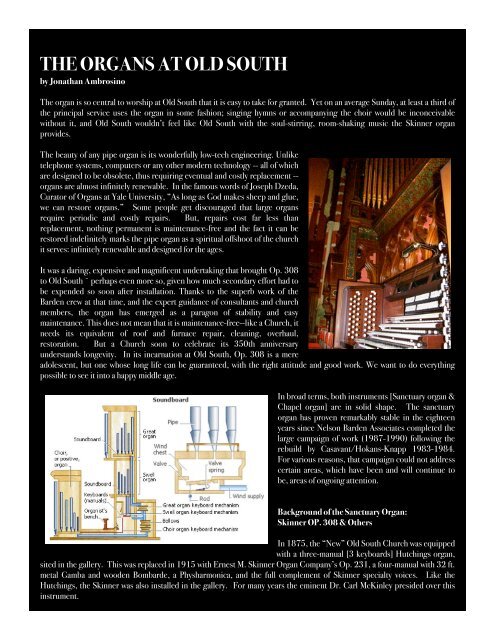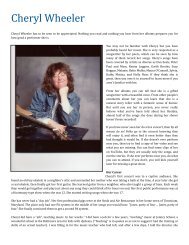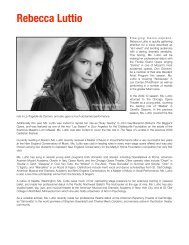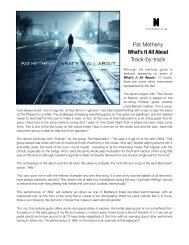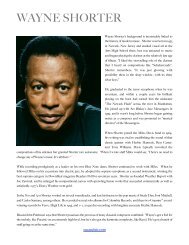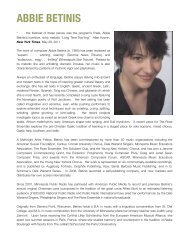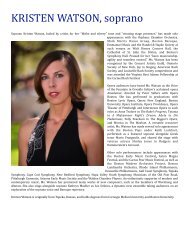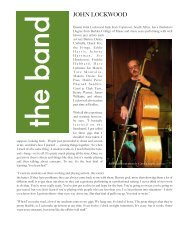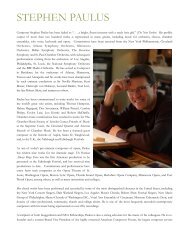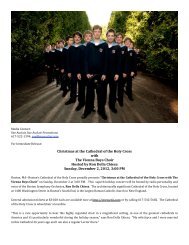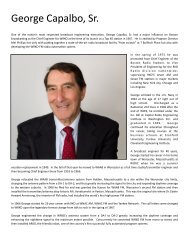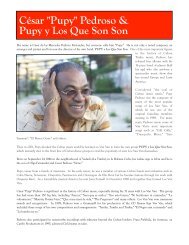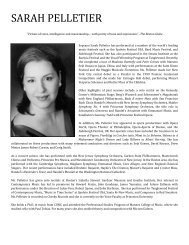THE ORGANS AT OLD SOUTH - Sue Auclair Promotions
THE ORGANS AT OLD SOUTH - Sue Auclair Promotions
THE ORGANS AT OLD SOUTH - Sue Auclair Promotions
Create successful ePaper yourself
Turn your PDF publications into a flip-book with our unique Google optimized e-Paper software.
<strong>THE</strong> <strong>ORGANS</strong> <strong>AT</strong> <strong>OLD</strong> <strong>SOUTH</strong><br />
by Jonathan Ambrosino<br />
The organ is so central to worship at Old South that it is easy to take for granted. Yet on an average Sunday, at least a third of<br />
the principal service uses the organ in some fashion; singing hymns or accompanying the choir would be inconceivable<br />
without it, and Old South wouldn’t feel like Old South with the soul-stirring, room-shaking music the Skinner organ<br />
provides.<br />
The beauty of any pipe organ is its wonderfully low-tech engineering. Unlike<br />
telephone systems, computers or any other modern technology -- all of which<br />
are designed to be obsolete, thus requiring eventual and costly replacement --<br />
organs are almost infinitely renewable. In the famous words of Joseph Dzeda,<br />
Curator of Organs at Yale University, “As long as God makes sheep and glue,<br />
we can restore organs.” Some people get discouraged that large organs<br />
require periodic and costly repairs. But, repairs cost far less than<br />
replacement, nothing permanent is maintenance-free and the fact it can be<br />
restored indefinitely marks the pipe organ as a spiritual offshoot of the church<br />
it serves: infinitely renewable and designed for the ages.<br />
It was a daring, expensive and magnificent undertaking that brought Op. 308<br />
to Old South ¯ perhaps even more so, given how much secondary effort had to<br />
be expended so soon after installation. Thanks to the superb work of the<br />
Barden crew at that time, and the expert guidance of consultants and church<br />
members, the organ has emerged as a paragon of stability and easy<br />
maintenance. This does not mean that it is maintenance-free--like a Church, it<br />
needs its equivalent of roof and furnace repair, cleaning, overhaul,<br />
restoration. But a Church soon to celebrate its 350th anniversary<br />
understands longevity. In its incarnation at Old South, Op. 308 is a mere<br />
adolescent, but one whose long life can be guaranteed, with the right attitude and good work. We want to do everything<br />
possible to see it into a happy middle age.<br />
In broad terms, both instruments [Sanctuary organ &<br />
Chapel organ] are in solid shape. The sanctuary<br />
organ has proven remarkably stable in the eighteen<br />
years since Nelson Barden Associates completed the<br />
large campaign of work (1987-1990) following the<br />
rebuild by Casavant/Hokans-Knapp 1983-1984.<br />
For various reasons, that campaign could not address<br />
certain areas, which have been and will continue to<br />
be, areas of ongoing attention.<br />
Background of the Sanctuary Organ:<br />
Skinner OP. 308 & Others<br />
In 1875, the “New” Old South Church was equipped<br />
with a three-manual [3 keyboards] Hutchings organ,<br />
sited in the gallery. This was replaced in 1915 with Ernest M. Skinner Organ Company’s Op. 231, a four-manual with 32 ft.<br />
metal Gamba and wooden Bombarde, a Physharmonica, and the full complement of Skinner specialty voices. Like the<br />
Hutchings, the Skinner was also installed in the gallery. For many years the eminent Dr. Carl McKinley presided over this<br />
instrument.
In the late 1960s, Dr. McKinley’s successor, Alfred Nash Patterson, sought a new instrument, which was eventually<br />
commissioned in 1968 from the Reuter Organ Company of Lawrence, Kansas and installed in 1969. This, too, was a fourmanual<br />
organ, with Great, Swell, Choir, Positiv, Bombarde and Pedal divisions. The two Skinner 32ft stops were retained,<br />
but all else was sold to Virgil Fox for use at his home in Englewood, New Jersey. (Eventually the pipes and parts were broken<br />
up for sale; the Kleine Erzähler and Flute Celeste found their way first to restorers in Detroit, and then eventually back to Old<br />
South via Nelson Barden.)<br />
In the early 1980s, under the tutelage of then-organist David Garth Worth, an effort was established to return the Skinner<br />
sound to Old South Church. Skinner Op. 308, built in 1921 for the Municipal Auditorium of Saint Paul, Minnesota, had<br />
suffered the fate of most municipal organs of its day. Although these organs opened to great fanfare, the advent of radio and<br />
sound pictures caused such instruments to be used less and less.<br />
Old South learned of the instrument’s availability mere weeks before the auditorium was to be razed and decided to act. A<br />
consortium was quickly formed to remove and store the instrument. The crew consisted of the A.Thompson-Allen Co.,<br />
Curators of Organs at Yale University, Foley-Baker Inc. from Tolland, Connecticut and Nelson Barden Associates of Boston.<br />
Once the heroic removal effort was completed, attention turned to how the organ could be installed in Boston. Some<br />
consideration was given to retaining the gallery arrangement, but Old South was ready to have music join with clergy in the<br />
chancel area. Such a job being beyond the capabilities of the New England restorers, other vendors were explored, and<br />
ultimately Casavant Frères, Ltée. of St. Hyacinth, Québec was chosen, in a two-contract arrangement with that firm’s regional<br />
representatives, Henry Hokans and Richard Knapp. The Reuter organ was sold back to Reuter in the early 1980s, who took<br />
it back to Kansas and repackaged it for a Baptist Church n Orlando, Florida.<br />
Nelson Barden Associates began a rebuilding program in 1986, made formal in 1987 under consultants Jack Bethards,<br />
Joseph Dzeda and Jason McKown, and church guidance from organist Frederick A. MacArthur, treasurer Tom Wardell, and<br />
member Wayne Davis. This particular campaign of work saw completion in June 1990, in time for the American Guild of<br />
Organists National Convention in Boston. In 1993, the Antiphonal organ received all new pipework from Austin. Nelson<br />
Barden Associates renovated the console in 1999, installing a new solid-state combination action.<br />
Blower and Blower Room<br />
The blower was completely overhauled in 1984, and the three static bellows<br />
rebuilt by Nelson Barden Associates in 1987. At that time, the blower room was<br />
re-engineered, cleaned, re-lighted, and fitted with filtered air supply via a duct that<br />
draws air from the Great/Pedal pit. We routinely monitor the grease in the blower<br />
motors and the cleanliness of their filters.<br />
Being in such a confined space, the blowers generate considerable heat and<br />
dryness. This has not promoted longevity of the three bellows there. Already the<br />
high-pressure bellows has had to be re-restored, and recently we undertook<br />
emergency repairs on the low-pressure bellows; further work will be needed in due<br />
course. The mid-pressure bellows appears stable for the moment.<br />
Climate control in this room would be tremendously useful, and should be explored as a means of promoting longevity of<br />
these three bellows. Also, humidification of the wind supply system would further promote longevity of the entire organ<br />
chassis.<br />
Windchests<br />
Given their complexity, organs have surprisingly few moving parts, most of which are found in the windchests. Underneath<br />
each pipe is a leather pouch and valve, conveying wind to that pipe. The leather is like that used in ladies gloves, and<br />
sometime thinner, but begins life with great tensile strength. As the organ is played, the leather pouches flex constantly.<br />
Even a short hymn entails thousands of individual pouch movements. As the leather decays, creases and tears develop, and<br />
notes go silent. In some actions, the notes sound all the time, and the pipes have to be muted until the leather is replaced.
There are approximately 6,900 individual leather movements to operate the 6,500 pipes in the Old South organ. (By<br />
comparison, the Chapel organ contains 1,411 leather movements to operate 1,164 pipes. )<br />
Pollution and age combine to cause leather deterioration. Typically, organs in urban areas are prone to earlier failure than<br />
their rural counterparts. Age is a further consideration, as leather quality declined along the course of the 20th century. As a<br />
result, organs in our stable of considerably different vintage (1925 Skinner, 1936 Kimball, 1965 Aeolian-Skinner, 1983<br />
Casavant) are all coming due for releathering about now.<br />
Fortunately, these organs are engineered for infinite renewal. Those elements upon which the leather is mounted are easily<br />
removed from the organ, and are restored in the workshop according to straightforward practices. Using the best available<br />
leather and restoration techniques gives the longest life from the next generation of work, and promotes the general health of<br />
the organ.<br />
When Casavant reconditioned the organ in 1983-84, the old leather was stripped off and new pouches fitted. Brown,<br />
vegetable-tanned sumac leather was used, which became standard practice for electro-pneumatic organs built after World<br />
War II. Research since the mid-1970s, however, led most American organ builders to eventually use white, chrome-tanned<br />
leather for these actions, since testing has demonstrated that chrome-tanned the leather might last fifty to sixty years, not<br />
twenty-five to thirty-five, as new brown leather seems to.<br />
Nelson Barden was the first restorer in North America to employ white, chrome-tanned leather in an organ restoration project<br />
¯ at Church of the Advent, on Beacon Hill. In<br />
the Barden rebuilding project at Old South,<br />
the issue of releathering was considered.<br />
However, the brown leather was new and<br />
clearly had value left, all while more pressing<br />
items demanded attention and resources. Thus<br />
the primary and pouch leather was left intact to<br />
lead out its useful life.<br />
Considering all the factors described above, it<br />
is not surprising that dead notes are now<br />
surfacing:<br />
a) the leather is now twenty-five years old,<br />
beginning the typical failure period for brown<br />
leather;<br />
b) Old South is situated upon one of America’s<br />
busier street corners;<br />
c) the first signs of failure are in hose<br />
mechanisms that do the most work: another<br />
typical sign.<br />
As this issue is approached over the next<br />
decade, three principles should be borne in<br />
mind:<br />
a) leather life left should be maximized<br />
wherever practicable;<br />
b) any work should be done in the most cost<br />
effective manner possible;<br />
c) dead notes and failures should not<br />
unreasonably impede the musicians.


